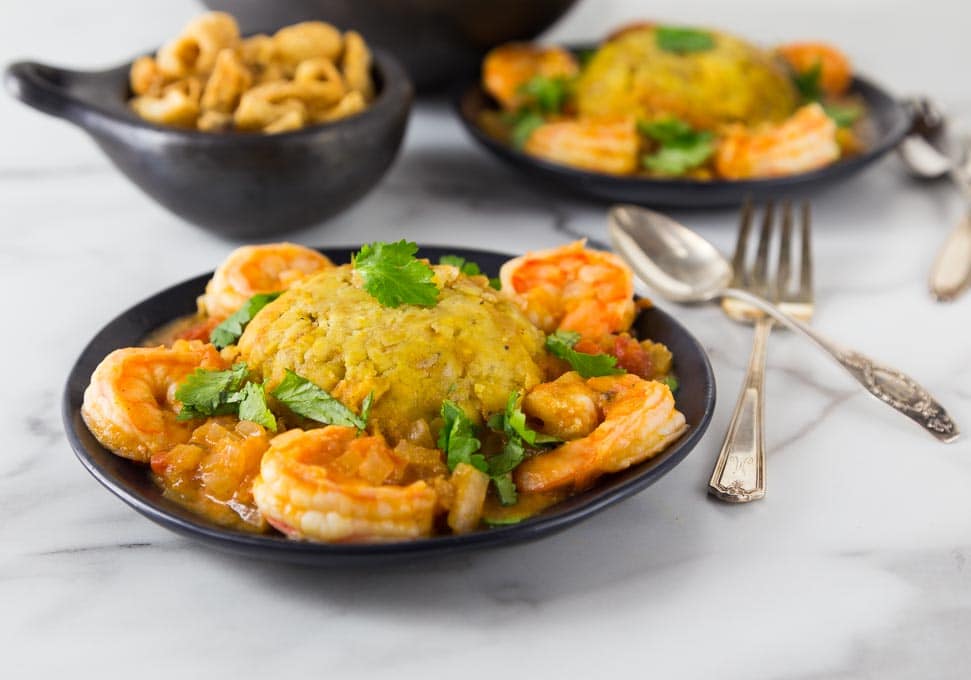
Growing up in Panama, Puerto Rican food on a menu was not an uncommon occurrence. One item in particular that always stood out to me was mofongo. What is mofongo? Comfort food at its finest. Today I was in the mood for seafood so I'm presenting you with Shrimp Mofongo. Enjoy!
Jump to:
What is Mofongo?
Shrimp monfongo is a beloved dish in Puerto Rico, second only to Arroz on Gandules, the national dish. Locals on the island love it. Walk into just about any small eatery and you can order a variety of different types of mofongo. It's made with mashed plantains. They're formed into a dome and deep fried before getting a pour over of hearty stew. Some recipe variations are hollowed out, making it a mofongo relleno. However, the taste remains about the same. The stew can be chicken, beef, shrimp, or pork.
Mofongo, while a humble dish, has a deep history with many backgrounds coming together. The dish originated when the Spanish began to colonize Puerto Rico in the 1500s. They brought enslaved West Africans with them on their ships. The newly arrived West Africans held their cooking traditions close. The one dish that stands out is fufu. Fufu is made from boiled, mashed root vegetables. Once cooked, the root veggies were pounded into a dough and served as a side in stews. Yuca was the most popular. In the case of Latin America, they went with what was most abundant: plantains.
The original Puerto Rican mofongo recipe was made in a pilon. It's essentially a wooden mortar and pestle. Unlike its African mirror dish, fufu, it's not boiled. The pilon is truly an ancient kitchen tool. It dates back to pre-Colombian times (1000 BC - 1400 AD). Archeologists have even found the humble pilon at excavation sites near Ponce and San Juan.
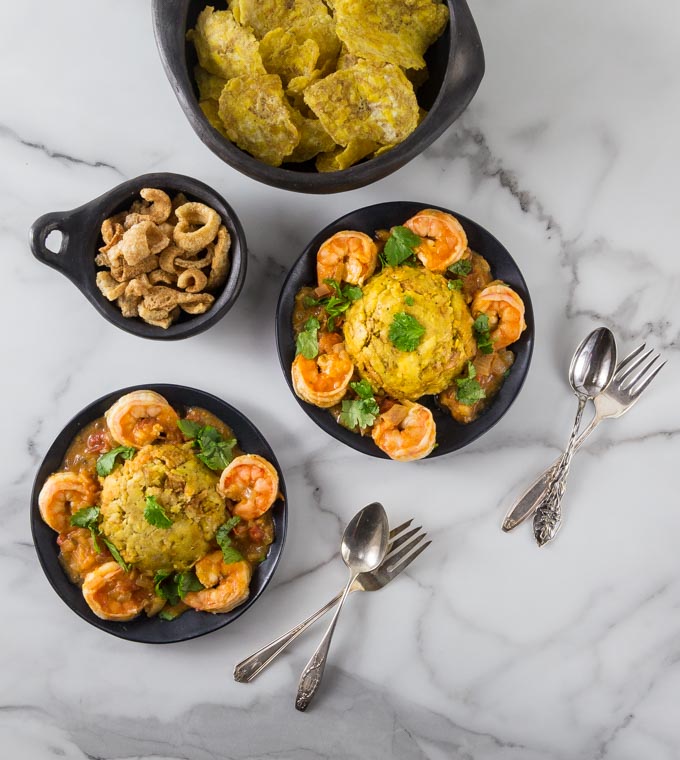
What are the key ingredients?
Mofongo is truly a blend of three cultures. How? First, using the pilon to mash up the plantains ties it to Puerto Rico and Latin America. The pounded and mashed starch element is deeply tied to West Africa. This part of the dish was inspired by fufu. (A recipe you should absolutely try!). Finally, mofongo got its Spanish flair from the sofrito sauce, commonly used as a stew for the protein.
So let's break it down a bit further. Not all mofongos are created equal. Some versions of the dish will use yuca or sweet potato in place of plantain. Not to worry, it is still fried to crispy goodness. The next thing you might run into are chicharrones, yes, pork rinds. Some versions of mofongo use bits of crispy pork in the mashed plantain. If you're vegetarian, make sure to double-check on this.
As a side note, my shrimp mofongo recipe is garlicy! I've had a few plates of mofongo over time that could keep the vampires away. My recipe is a suggestion because I like the garlic flavor to be balanced with the others. If you're a garlic lover, by all means throw in a couple more cloves for that garlicy punch.
What are Plantains?
Plantains are very different from a banana. So look closely when you're in the produce aisle. I wouldn't recommend using a banana for your mofongo. If you can't find plantain at your local bodega or supermarket, opt for sweet potato or yuca.
But I digress, plantains are in the banana family but are far removed. They are usually green with black spots and have a much thicker skin. Texture-wise, plantains are starchy and cannot be eaten raw. (You might get sick!). You'll need to bake, boil, fry, or stew them until they're soft (or crispy if you're frying!). They likely originated in South East Asia but are often found in tropical cuisines.
Preparing Your Plantains
Peeling plantains can be a bit tricky. They do not come apart as easily as a banana. To avoid a trip to the ER, I recommend that you cut off the ends and then cut the green skin (carefully) length-wise on either side. You should be able to peel it one side at a time. Go slowly though, if you don't catch the whole peel you'll be cutting away fibers to get to your precious plantain.
How to make shrimp mofongo step by step

- Gather all your ingredients and have them measured, chopped and ready to go. The French call this "mise en place" or "everything in place" and it is the only way to master a dish and get it right. Buy some prep bowls
of various sizes to get your game on!
- Heat a skillet on medium and add the olive oil, onion, tomato and adobo. Stir and allow to cook until the onion is translucent.
- Once the onions are very soft add the smoked paprika
, white wine and sofrito. Stir and simmer for 3 minutes to allow the flavors to combine.
- Add the shrimp and cook on one side for about 2 minutes then flip. Cook for another 2 minutes on the other side until done. This time may vary a bit base on the size of your shrimp. They are done once they are just firm. Remove from the heat, cover and set aside to keep warm.
- Cut the ends off of the plantains.
- Take a small thin bladed knife, cut just below the thickness of the skin.
- Carefully peel the skin away by prying it with your thumbnail.
- Slice the plantain into pieces that are about 1 inch thick.
- Heat oil in a pan to 325°F and fry for 2 minutes on one side and flip and repeat. The middle should feel soft when you poke with a fork.
- Place 2 garlic cloves on a large mortar
or if you have a pilón use it and smash it.
- Mash the garlic until it is fully pulverized around the mortar or pilón then add the plantain slices and mash them. Note: If you want a softer mashed plantain add a little water, 1 teaspoon at a time.
- Once all the plantain is mashed, add the pork rinds or chicharrones.
- Separate the smashed mixture into 2 halves and press into a small bowl to form 2 half spheres as shown.
- You can drop out the formed mofongo on the cutting board and serve with the shrimp and sauce.
Frequently Asked Questions:
- How long can I store the shrimp and sauce in the refrigerator? Once they have cooled you can store them in the refrigerator in an airtight container for 3-4 days.
- How do I reheat the shrimp and sauce? Reheat the shrimp in the microwave for 2-3 minutes and stop to stir every 30-45 seconds until hot.
- Can I freeze the shrimp in the sauce? Yes, allow them to cool and you can freeze in airtight containers for up to 2 months. Thaw completely in the refrigerator and then reheat in the microwave.
- Can I freeze the mofongo? It is really best to serve the mofongo freshly mashed for best results. I would not freeze it.
Here are few of my all time favorite Puerto Rican dishes: If you are a fan of pulled pork then you must try this slow roasted pork shoulder or pernil. During Christmas you have to make this egg-free nog with coconut and rum called coquito that is so creamy and delicious! One of the best steak dishes I have ever eaten has to be bistec encebollado or steak and onions. The bold flavors are amazing!
📖 Recipe
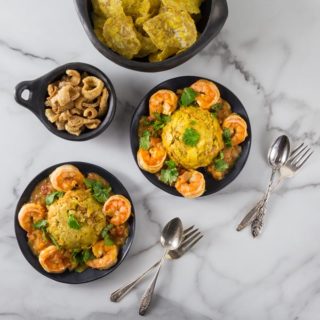
Easy Shrimp Mofongo Recipe
Ingredients
Shrimp and sauce:
- 1 tablespoon olive oil extra virgin
- 1 onion medium, diced
- 1 cup tomato diced, fresh
- 1 teaspoon adobo
- 4 tablespoon sofrito
- ¼ teaspoon smoked paprika
- ½ cup white wine
- 1 lb shrimp peeled and deveined
Mofongo:
- 2 plantains green
- 2 cloves garlic
- ¼ cup pork rinds chicarrones
- oil for frying
Instructions
Prepare the shrimp and sauce:
- Heat a skillet on medium and add the olive oil, onion, tomato and adobo. Stir and allow to cook until the onion is translucent.
- Once the onions are very soft add the smoked paprika, white wine and sofrito. Stir and simmer for 3 minutes to allow the flavors to combine.
- Add the shrimp and cook on one side for about 2 minutes then flip. Cook for another 2 minutes on the other side until done. This time may vary a bit base on the size of your shrimp. Once they are just firm they are done. Remove from the heat, cover and set aside to keep warm.
Prepare the mofongo:
- Cut the ends off the plantains. Take a small thin bladed knife, cut just below the thickness of the skin.
- Carefully peel the skin away by prying it with your thumbnail.
- Slice the plantain into pieces that are about 1 inch thick.
- Heat oil in a pan to 325°F and fry for 2 minutes per side and flip and repeat. The middle should feel soft when you poke with a fork.
- Place 2 garlic cloves on a large mortar or if you have a pilón use it and smash it.
- Once the garlic is fully pulverized around the mortar or pilón add the plantain slices and mash them. Note: If you want a softer mashed plantain add a little water while mashing, 1 teaspoon at a time.
- Once all the plantain is mashed, add the pork rinds or chicharrones.
- Separate the smashed mixture into 2 halves and press into a small bowl to form 2 half spheres. Pop out the mofongo from the bowl, plate and serve with the shrimp and sauce.

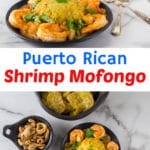
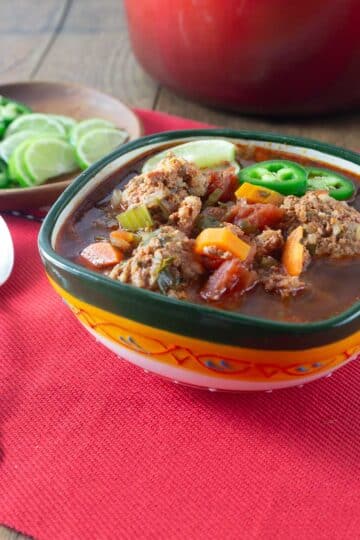
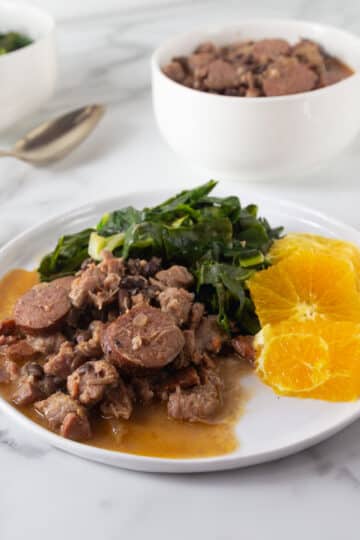
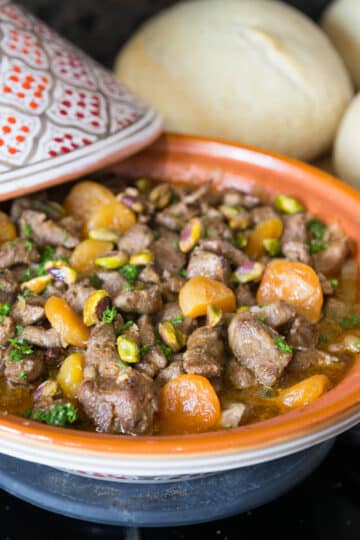

Miriam says
I boiled instead of fried the plantains for time sake and it was delicious. This one is a keeper!!
Analida says
Thanks for the tip Miriam! I will give boiling a try the next time I make this!